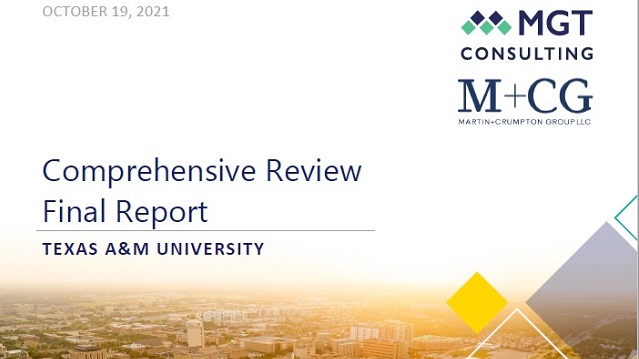
Texas A&M’s president has received the recommendations of an outside consultant regarding possible administrative changes.
Click HERE to read and download the consultant’s report.
A online statement issued by Katherine Banks includes an invitation to provide input on the consultant’s recommendations at feedback.tamu.edu. According to that statement, Dr. Banks will announce her recommendations in early December.
In a statement to WTAW News, Banks said after she announces her recommendations, “An implementation oversight committee and working groups will be formed and campus forums will be held. Over the next semester, the implementation oversight committee and working groups will move forward with planning and implementation procedures for complete implementation by Sept. 1, 2022.”
The consultant’s findings followed three months of conducting more than 60 in-depth interviews with key university leaders, holding strategic surveys of university deans and vice presidents, faculty and staff, current students, and former students, and doing in-depth research to identify best practices and trends in higher education through a peer review of more than 20 leading universities.
Additionally, the consultant reported approximately 500,000 members of the TAMU community were invited to participate in three separate surveys between August 11 and August 20, 2021. Among the individuals invited to participate in the surveys were 58 deans and vice presidents, 1,775 current students, 3,654 faculty and staff members, and 16,500 former students responded.
Quoting six high level findings in the 133 page report:
The consultant team consistently found the university’s operational structure is decentralized, resulting in ineffective use of talent and resources.
This is consistent across most units, colleges, and campuses, including Finance, Information Technology, Human Resources and Organizational Effectiveness, Facilities, and Texas A&M Health. Some of these groups are quite large, such as Human Resources and Organizational Effectiveness, which employs approximately 500 part-time liaisons, and Information Technology, which employs more than 300 part-time liaisons. The decentralized model makes it difficult for functional operations to remain consistent in processes, technology use, and objectives. As a result, talent and financial resources are not used in a practical or transparent method, and students, faculty, and staff do not have complete clarity when seeking help from operational units. A misalignment of oversight responsibilities has resulted in a duplication of efforts, ineffective initiatives, and unnecessary administrative burdens on faculty and staff.
High-level recommendations:
• Strengthen the effectiveness and consistency of the overall operational structure by expanding the role of the President’s office.
• Centralize the Information Technology, Human Resources and Organizational Effectiveness, Facilities, Marketing and Communications, and Finance units across the university to increase effectiveness and clarify responsibilities.
Inconsistent transparency and a lack of strong operational analytics and performance metrics across units, colleges, and campuses creates operational inefficiencies as well as unclear responsibility and accountability necessary for operational success.
The lack of existing operational data and analytics is a factor preventing the improvement of current processes, procedures, and resources use, particularly for units such as Facilities and Information Technology, which require accurate data to effectively manage the university’s space, security, and technology needs.
High-level recommendation:
• Gather data on day-to-day operations of operational units and implement a system of continuous improvement build on performance analytics to understand where misalignment or ineffective use of resources exists.
Marketing and communication efforts across the university are often uncoordinated, resulting in unclear communication and inconsistent efforts that do not further the university’s mission or allow for two-way communication with its key audiences.
Branding and communication responsibilities among the university’s operational and academic units are unclear, leading to inefficient processes and creating duplication of efforts and the way resources are utilized.
High-level recommendation:
• Centralize the Division of Marketing and Communications to ensure effective and consistent branding and communication efforts take place across all operational and academic units.
Faculty and staff talent management is a critical issue.
There is a lack of professional development opportunities along with clear succession planning in the operational units, which is a significant threat considering more than 20 percent of the university’s employees are currently over 65 and possess enormous amounts of institutional and process-specific knowledge that is not formally shared. A high internal staff turnover rate, a relatively small pool of qualified potential employees in Bryan/College Station, and the recent increase in remote job offerings nationally spurred by Covid-19 are also threats to retention. Creating consistent and effective processes, employee training programs, and clear opportunities for advancement should alleviate many of these threats over time. Consistent processes will allow individuals to step into new roles more easily when required, prevent crises, and allow units to focus their resources on proactive initiatives versus reactive efforts. Given the ever-changing landscape of expectations for teaching, research, and service, it is of particular importance to provide the faculty a platform through which they can voice concerns and engage in discourse with senior administration. The creation of a system that supports faculty development and recognition and the ability for them to provide more direct feedback to the institution is vital to faculty retention. Shifting dynamics, coupled with concerns over ambiguity and micro-politics central to the tenure process, are just some of the challenges facing faculty as they strive to progress in their careers. In addition, there is a perception that excessive bureaucracy and delays in decision making in the Office of the Provost has hindered the faculty’s ability to perform the essential functions of education and research.
High-level recommendations:
• Invest in staff development and succession planning to allow leadership to continue improving campus operations.
• Increase the university’s direct support of the faculty by creating a Faculty Affairs unit that reports directly to the President and will focus exclusively on faculty issues.
A coherent, strategic academic organization centralization and targeted realignment of academic units would greatly enhance operations and unit focus.
This will ultimately increase the effectiveness and strength of the academic units and colleges, elevate student success, and further major university initiatives. The academic foundation of the campus could be developed around four large units: AgriLife, Engineering, Arts and Sciences, and Texas A&M Health, with strong connections to other applied academic units. Changes are necessary to increase organizational effectiveness and positively impact students, faculty, staff, and broader community constituents, and must be propelled by collaboration.
High-level recommendations:
• Refocus the provost unit on academic services and student success to further the university’s academic mission.
• Rebalance the university’s investment to ensure that the four large academic units mentioned above correspond in terms of support and there is appropriate investment in targeted academic units of strategic interest.
• Realign several academic units to allow for focus on mission, increase student success, and better meet student needs.
Large portions of the interview and survey audiences were conflicted about the university’s culture and diversity, equity, and inclusion (DEI) efforts.
Some survey respondents believe the DEI efforts are ineffective, resulting in an inability to recruit underrepresented student, faculty, and staff populations. Others have questions about the effectiveness of resources invested in DEI that could be used to invest broadly in education-focused endeavors for the entire student population.
High-level recommendations:
• Invest in recruitment efforts by creating an Office of Undergraduate Recruitment. The office should be overseen by the new Academic and Strategic Collaborations unit, which will work to increase engagement with both the local community and Texas at large. Clear success metrics must be defined and reported regularly.
• Ensure Student Affairs focuses on its critical role in the development of the whole student. Students who participate in Student Affairs programs and services should expect to become well-trained leaders, understand the value of being accountable to the larger campus community, and uphold the Aggie Core Values.
Statement from president Katherine Banks to WTAW News:
Today, we are calling on Texas A&M stakeholders to offer input as part of a process to reach our shared goal of positioning this university to be a global leader in academics and research for decades to come. To identify areas of potential improvement, a consulting group was engaged and a review was conducted. The resulting report has been placed online at feedback.tamu.edu. Input from Texas A&M stakeholders will be accepted over the next two weeks. All perspectives are important and will be considered. I anticipate announcing in December, after careful review of the input, which recommendations will be accepted, rejected, modified or require further study. An implementation oversight committee and working groups will be formed and campus forums will be held. Over the next semester, the implementation oversight committee and working groups will move forward with planning and implementation procedures for complete implementation by Sept. 1, 2022.
News release from Texas A&M president Katherine Banks:
During my first weeks as president, I held listening sessions with the leadership of our colleges and schools, faculty, staff, students, former students and other key stakeholders, to hear their challenges, opportunities and ideas.
In addition to listening sessions, I also focused on learning. I reviewed many strategic plans that were developed throughout various units, university-wide.
Over the past four months, one of the premier consultancies in higher education has reviewed our administrative functions and structure.
The report of the findings and recommendations has been provided to Texas A&M. The next step in our process is critically important: receiving reaction and feedback by the entire university community regarding the recommendations in the report.
The report has been posted online at feedback.tamu.edu. I invite you to review the report and provide your thoughts on the website form.
Input will be accepted on this website over the next two weeks. We are utilizing an external firm to collect and analyze the input to ensure a thorough and unbiased evaluation. This will allow me and our leadership team to review all the information in an efficient manner.
I want to underscore the importance of sharing your feedback. All perspectives are important and will be considered. The survey asks for name, UIN and connection to the university. This information will not be provided to the university in the analysis; it is intended to provide the firm with a sense of respondent representation.
After thorough review of the input, I anticipate announcing in early December which recommendations will be accepted, rejected, modified or require further study.
Next steps will include the formation of an implementation oversight committee and working groups. Nominations will be requested to identify those to serve on these groups.
Forums will be held to discuss implementation. Again, your feedback at that time will be a crucial part of our process.
I look forward to your participation as we move forward.
